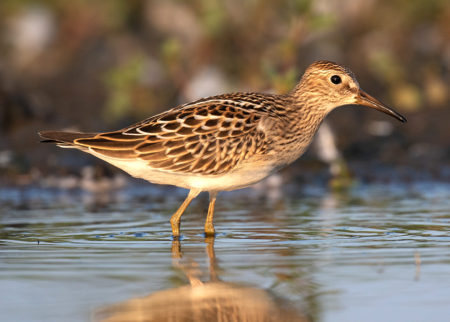It’s that time of year again – spring migration! Migratory birds have started making their way to the temperate areas of the globe for breeding, Some of these birds have spent the entire winter in the Caribbean and others are passing through as part of a longer journey. In both cases, the Caribbean provides essential habitat that supports these fearless travelers. Safe, clean places to rest and refuel are critical to their survival.

Some of the longest trips made this spring will be completed by the arctic-breeding shorebirds. If you catch a glimpse of a Red Knot in the next few weeks, you are seeing it on just a small part of its 9,300 mile (15,00 km) journey! Shorebirds are both incredible athletes and world travelers: they can travel hundreds of miles a day without rest and pass over continents in weeks.
Capturing data of birds during migration is vital to understanding their status, distribution, and how they are using sites in the Caribbean throughout their life cycle. While you are out birding don’t forget to log your observations in eBird Caribbean. If you are visiting a wetland, please do a Caribbean Waterbird Census (CWC) count! The regional count occurs in January and February, but CWC data is collected year-round! When entering your data on eBird, on Step 2 “Date and Effort” page, be sure to choose either the “CWC Point Count” “CWC Traveling Count” or “CWC Area Search” observation type. (you can also choose one of these options if you are using the EBird Mobile app – adjust your settings – choose eBird Caribbean as your portal and the options will show up!)
Is that a Least Sandpiper or a Western?
Earlier this year, we redesigned an existing poster of common shorebirds in the Caribbean which features many of the sandpipers, plovers and larger shorebirds that you may see while birding. This poster is a great resource because: 1) it shows the relative size of the shorebirds to each other and 2) all the birds are in their winter plumage. In their non-breeding plumage shorebirds – especially peeps – can be challenging to identify. We hope that this resource is a helpful guide for those learning their shorebird identification.
The poster is also available in Spanish and French. Below the English common name and scientific name, the common name of the bird appears in Spanish for Cuba, the Dominican Republic, and Puerto Rico. For example, the Red Knot has three Spanish common names: Zarapico Raro (Cuba), Playero Gordo (Dominican Republic), and Playero Pechirrojo (Puerto Rico). If only two Spanish common names appear, this indicates that two of these three countries have the same common name for the bird.
Do you have access to a large format printer and want to have a hard copy of this beautiful resource? The poster is the perfect addition to wildlife offices, public education spaces, or to have on hand for events like presentations and bird festivals! Larger versions of the posters can be downloaded here: French, English and Spanish.
We very much appreciate the National Audubon Society and the Bahamas National Trust allowing us to redesign their original poster and for Manomet’s input during the process. We thank the Canadian Wildlife Service for supporting poster printing costs in 2019. Participants at the Conserving Caribbean Shorebirds and Their Habitats Workshop were treated to small versions of the poster thanks to a generous donation from the Puerto Rico Department of Natural and Environmental Resources.



